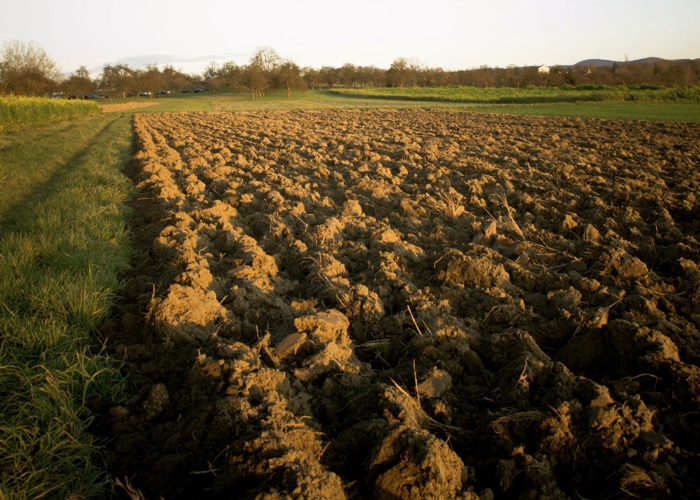In the last issue of Grainews I wrote about the effects of compaction on soil. Now, I’ll discuss the specific types of soil compaction and the ways each type can be managed.
1. Surface soil crusting
This type of compaction is caused by a combination of soil tillage and raindrop impact.
Causes: Tillage can bury much of the protective residue cover on the soil surface and degrade the granular structure of surface soils. Falling rain will cause soil aggregates to break down into smaller particles that can become suspended in water, flow together and then dry into a hard surface soil crust. The crusted soil can restrict water infiltration into soil and restrict crop emergence.
Read Also

Gentle treatments for pain in the neck
Heading toward year-end, people unknowingly tense up against the cold and busyness, causing neck pain that can often be treated with appropriate support and gentle mobility, athletic therapist Kathlyn Hossack says.
Diagnosis: Crusted soils are relatively easy to diagnose by simply examining the soil surface to see if soil aggregates have broken down and a tough soil crust has formed. Visual examination of the soil crust will reveal a plate-like, horizontal layered structure. If a crust is observed after seeding and germinating seedlings cannot break through the surface crust, plant population can be greatly reduced.
Correction and prevention: A short-term solution after seeding is to lightly fracture the crust using a light harrowing or rolling with packers to aid seedling emergence.
The best way to prevent soil crusting in fields is to minimize tillage operations and ensure that a protective layer of residue remains on the soil surface to absorb water droplets before they strike and break down stable soil aggregates. This can be achieved by reduced tillage or direct seeding practices. Including a forage in the crop rotation can also aid in the long-term development of a good granular-structured soil that has greater resistance to breakdown and crusting.
2. Subsurface compaction, hardpan
Causes: A tillage-induced compaction layer is sometimes called “hardpan,” or “plow pan” and occurs in the layer of soil just below the depth of tillage. It occurs when soils are cultivated repeatedly at the same depth. The force of the tillage equipment, such as discs or cultivator shovels, can cause compression of the soil and smearing at the base of contact between the soil and tillage implement. Usually the compacted layer is one or two inches thick.
Compaction will increase when soil moisture conditions are wet at the time of tillage and/or if soils have a higher silt and clay content. In extreme cases, the compaction can be quite serious, affecting water and root penetration into the subsoil. However, with coarser textured soils, the hardpan tends to be weaker and more friable, and may have less effect on crop production.
Diagnosis: Hardpan can be detected by using a shovel or trowel to carefully shave away the tilled surface soil to the depth of the tillage layer, until the top of the hardpan is exposed. The hardpan can be examined visually to see if plant roots are growing horizontally along the surface of the hardpan, which is a good indicator that roots are having difficulty penetrating the hardpan.
Correction and prevention: It has generally been assumed that compacted soil layers break down naturally with annual freeze-thaw and wetting-drying cycles. When a hardpan soil layer persists, the soil may need some form of tillage to physically break up the hardpan.
When soils are relatively dry, use a heavy-duty cultivator with spikes to penetrate just below the hardpan to fracture and break it up. This should be done in the fall when soils are dry. Great care is needed to maintain residue on the soil surface to prevent soil erosion and not intermix subsoil with topsoil.
Tillage may reduce the hardpan compaction, but it may not address the sources of the problem. It may take three to five years of reduced tillage or direct seeding practices, freeze-thaw cycles and the use of a combination of taproot and fibrous-rooted crops to correct the hardpan problem. Deep ripping equipment should not be used.
To avoid the development of a tillage-induced hardpan, land should be direct seeded to minimize tillage. If soil must be tilled, ensure soils are not too moist, and vary the depth and direction of tillage. For land seeded to row or root crops, soils should not be worked when wet.
3. Wheel traffic-induced compaction
Causes: Heavy farm equipment, including tractors, grain carts, combines, trucks, high clearance sprayers and manure spreaders, can exert considerable weight onto the soil surface and into the subsoil. The effect of equipment weight can penetrate and cause compaction to a depth of about 24 inches when soils are very moist. As farm equipment continues to increase in size and weight, wheel traffic-induced compaction may become a more serious concern in the future.
Wheel traffic compaction has increased in the past several decades due to the increasing size of farms, farm equipment and the time needed to complete farm operations at seeding and harvest. With the increasing axle weight of equipment, care is needed when soils are quite moist to minimize the potential for wheel traffic compaction. In spring, when soil moisture conditions tend to be higher, the risk of soil compaction is often the greatest.
Diagnosis: Examining crops growing in a field can help diagnose wheel track compaction problems by the evidence of reduced crop growth in wheel track areas. A key diagnostic is seeing poor crop in line with wheel spacing of heavier equipment. Use a shovel to dig up plants in affected and unaffected areas. Carefully examine plant roots from healthy, areas versus those from problem areas to see if growth is being affected by compaction. Plants from compacted areas may have malformed or restricted root development. Roots from a compacted soil area may also be confined to the upper layer of soil with minimal penetration into the subsoil.
A soil penetrometer can be used as a diagnostic tool to measure the extent and depth of subsurface soil compaction. Normally, only researchers and agricultural consultants have this type of diagnostic equipment.
If compacted areas are detected, use a shovel to dig soil pits to examine the soil or to use a hydraulic soil coring unit to confirm the soil is compacted. A soil texture change or a dry soil layer can mimic compaction when using a penetrometer, but there may not necessarily be a compacted soil layer. It is critically important to use more than just a penetrometer to diagnose soil compaction.
Correction and prevention: Wheel traffic-induced compaction can be managed using good agronomic practices, deep tillage or both.
Where wheel traffic has created compaction to a depth of 12 to 24 inches, use deep tillage to fracture the compacted soil zone. Deep tillage implements have been developed to effectively loosen compacted soil layers. Avoid using subsoilers or deep rippers that cause considerable mixing of top soil and subsoil layers.
One type of implement that works successfully has shanks slanted at a 45-degree lateral angle. As the angled shanks slice through dry soil, the soil is lifted slightly, shifted to the side and dropped back into place. This lifting-shifting-dropping action fractures the dry soil to reduce the soil density. Some units have adjustable shatter-plates behind the shanks to increase or decrease the disturbance of the soil.
The soil profile must be dry to achieve the necessary fracturing to loosen and reduce the density of the soil. Ideally, implements must leave the soil surface relatively undisturbed, and leave topsoil and subsoil unmixed.
Mechanical deep tillage is only a short-term solution to soil compaction and is very expensive. It is costly to purchase or rent specialized deep tillage equipment, and the operating costs are also expensive; it’s important to diagnose this problem correctly. In the long term, farming practices may have to be modified to minimize wheel traffic compaction.
The following strategies can minimize wheel traffic-induced soil compaction:
- Minimize traffic in fields when subsoil is wet;
- Minimize axle loads by increasing the number of tires on implements for weight distribution;
- Use the lowest acceptable tire pressure;
- Tracks may give better weight distribution than tires, but minimize track slippage, which could cause increased surface soil problems;
- Use headlands for heavier equipment and traffic, including for loading and unloading, to limit compaction areas.
Adverse effects of deep tillage
Deep tillage can be beneficial under specific soil conditions, but use can also have serious negative effects on soil quality. Consider potential concerns:
- Some rippers cause greater mixing of surface soil with subsoil, which results in the deterioration of soil structure, reduction in soil organic matter, reduced soil fertility and increased potential for surface soil crusting. This can be worse than minor soil compaction problems.
- Loss of plant-available moisture can occur.
- Soluble salts in subsoil can be intermixed with surface soil, increasing salt levels and reducing crop yield potential.
- Subsoiling can make the ground surface rough and lumpy and can pull rocks to the surface.
- A subsoiled field may have a poor seedbed the following year due to an uneven and soft surface soil and reduced soil moisture conditions.
- If high or excessive amounts of moisture are received after subsoiling, the fractured soil can become a challenge to manage until dry.
Ideally, I usually suggest trying ripping test strips in a field to evaluate the benefits and risks over one or even two years before deep ripping an entire field.















